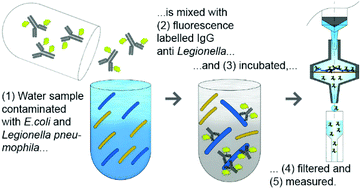Detection of targeted bacteria species on filtration membranes†
Abstract
The detection of pathogens in aquatic environments issues a time-consuming challenge, but it is an essential task to prevent the spread of diseases. We have developed a new point-of-care (POC) method for the fast and efficient detection of Legionella pneumophila in water. The method consists first of the generation of immunocomplexes of bacteria species with its corresponding targeted fluorescence-labelled serogroup-specific antibodies, and second a concentration step of pathogens with a membrane filter. Third, on the filtration membrane, our method can detect the fluorescence intensity corresponding to the pathogen concentration. Thus selective and efficient evidence for the presence of bacteria can be evaluated. We tested our system on fluorescent Escherichia coli bacteria and were able to reach an accurate determination of 1000 cells. The technique was furthermore tested on Legionella pneumophila cells, which were labelled with fluorescence-labelled antibodies as a proof of principle. Furthermore, we were able to verify this method in the presence of other bacteria species. We were able to detect bacteria cells within half an hour, a substantial advancement compared to the prevailling state of the art detection method based on the cultivation of Legionella pneumophila. Hence, this system represents the basis for future developments in analysis of pathogens.



 Please wait while we load your content...
Please wait while we load your content...